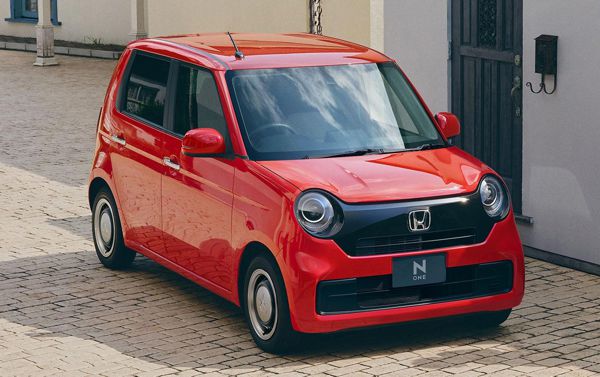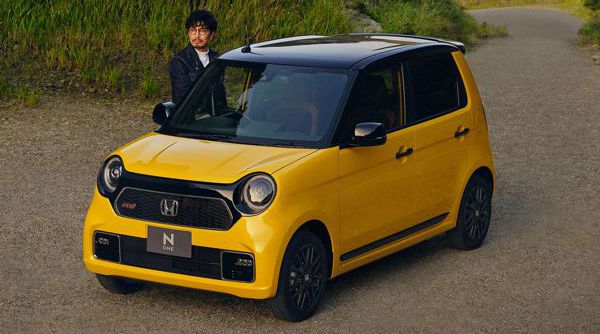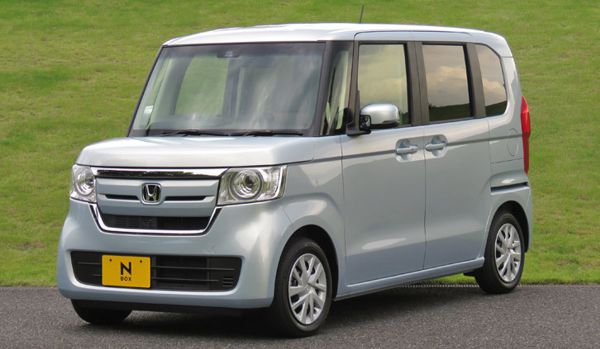Published on 9
Oct 2021
|
All rights reserved.
|
|
| N-One |

|
|
After
8 years, the N-One still looks the same, which is not bad.
|
|
In recent years, the
market share of K-cars grows to over 40 percent of the domestic market.
Not only traditional players like Suzuki and Daihatsu, but “normal
cars” manufacturers like Toyota, Honda and Nissan also joined the
battlefield. Among them, Honda is the most successful. Its N-series
cars took the best-selling car title in Japan and contributed to more
than half the cars Honda sold in its home market.
Because of intense competition, K-cars usually get full makeover every
5 years or so to keep them fresh to the eyes of customers. However, the
last N-One survived for 8 long years, thanks to a cute yet refined
design that never ages. For this reason, Honda decided to focus on the
underpinnings and leave the lovely exterior largely unchanged. Here, we
are not talking about the subtle evolution between iterations of VW
Golf
or Mini. Honda not only kept all the hardpoints unaltered but also
carried over most body panels: bonnet, fenders, doors, roof and even
tailgate. So, what have been changed? The fascia, the front and rear
bumpers, LED head and tail-lights. Even the windows are interchangeable
between the new and old cars. Too lazy? If the old design still looks
fabulous, why change for the sake of change?.

|
|
Interior
is finished at high standard.
|
|
What the old car really needed to change was the interior, and the new
car gets an overhaul. The dashboard gets slimmer to free up space. The
touchscreen is positioned higher for easier reading. The air-con
switches are placed closer to the driver for easier access. The new
steering wheel not only looks smarter but also incorporates audio and
infotainment controls on its spokes. In addition to slimmer A-pillars
and replacing bench front seats with individual ones, ergonomics is
greatly improved. As for styling, the new
instrument binnacle looks a bit strange with a partition set between
analogue gauges and driving information display. However, overall this
is still a more stylish cabin, thanks to a decoration panel covering
the main surface of the dash. It can be ordered in different colors or
finished in wood grain. Depending on trims, the steering wheel’s lower
spoke, air vents, gearshifter surround and seat fabric can be
color-coded. Moreover, the plastics used in this cabin generally look
higher quality than in other K-cars. All these make the N-One feel
almost premium.
What it does not need to change is the clever layout. As before, the
N-One has its fuel tank placed underneath the driver seat, freeing up
the space under rear seat. This allows the latter to flip up to reveal
a tall luggage space, or fold down and drop to the floor to form a flat
load bay. Yes, the trick learned from Fit / Jazz. Very few K-cars offer
this kind of luggage versatility.
As the old car already rode on a class-leading 2520mm wheelbase, there
is no room for further improvement I would say, so the Mk2 keeps all
essential dimensions unchanged. However, that does not mean no
improvement to the chassis. By using more high-strength steel and
structural adhesives in its construction, the body-in-white is made
stiffer yet 7 percent lighter. Fluid-filled engine mounts, enhanced
sound proofing and acoustic front windows cut NVH. By offsetting the
springs on MacPherson strut front suspensions, lateral cornering forces
are reduced, resulting in smoother ride and higher cornering stability.
Besides, the N-One is equipped with a safety suite called Honda Sense,
which offers adaptive cruise control, lane keeping and traffic jam
tracking. And unusually, this is fitted as standard on all trims.

|
|
RS
gets turbo power and 6-speed manual gearbox from S660.
|
|
As for powertrains, Honda claims the S07B three-cylinder engines are
new, but its power and torque figures are actually the same as before –
58hp and 48lbft for naturally aspirated version, 64hp and 77lbft for
turbo. Although some testers said the naturally aspirated motor felt
torquer than the old unit at lower revs, its peak torque actually
arrives 100 rpm later than before. It seems to me that the key
development from S07A to S07B was to make it comply with stricter
emission standard without losing power. Anyway, Honda’s K-car engines
have always been slightly more powerful than rivals. As the N-One
managed to avoid gaining weight, it also feels brisker than others.
While some rivals could feel painfully slow and breathless with
naturally aspirated motor, the Honda is truly usable.
Of course, if you regularly travel on highway, turbocharged version is
recommended. More interesting is the RS trim, which can be ordered with
a close-ratio 6-speed manual gearbox sourced from S660. It offers light
and accurate gearshift, not to mention the fun of driver engagement
that you won’t get from a CVT. The standard CVT has been modified to
reduce rubberband
effect. Still, lag and noise are not completely banished.
While N-One RS with exclusive turbo motor and 6-speed manual gearbox
sounds exciting, it is no S660. Being tall and narrow, this is still a
conventional K-car in terms of handling. It also lacks any suspension
beef-up to improve body control or roadholding. This means, it is
designed primarily for urban driving, although its steering, gearshift
and turbo power do give more driver satisfaction.
|
Verdict:     |
Published on 9
Oct 2021
|
All rights reserved.
|
|
| N-WGN |

|
|
In
the mold of Suzuki Wagon R.
|
|
While the footprint of
K-car is strictly limited to 3.4 meters long and 1.48 meters wide,
height is loosely regulated at 2 meters. This gives manufacturers
opportunity to explore extra space from height. The 1993 Suzuki Wagon R
was the first tall-body K-car. It was hugely popular in Japan while the
country was suffering from a long economic depression. It was soon
followed by Daihatsu Move. Honda N-WGN follows the same path. Its roof
stands 1675mm above the ground, or 130mm taller than the N-One, while
the body is shaped so boxy that not a single cubic inch is wasted.
Ridiculously, the second generation N-WGN is styled more like Wagon R
than its predecessor, sharing the Suzuki’s minimalist and no-nonsense
form. As a result, it lacks the strong personality of N-One.
The underpinnings are shared with the N-One and N-Box, which means the
fuel tank is mounted centrally beneath the driver seat. However, while
this arrangement allows the N-One to flip up its rear seat to place
tall luggage or fold down and drop its rear seat to form a flat load
bay, the N-WGN’s extra height allows the same capability without
resorting to a tricky rear seat. Instead, its rear seat just slides
back and forth. When it folds down, it aligns with the parcel shelf and
forms a flat loading area. Compared with the last generation, the boot
floor has been lowered together with a deeper tailgate opening, so
loading heavy items becomes easier.
As in N-One, the new chassis gets stiffer yet lighter. Thinner
windscreen pillars offer great visibility. Larger and wider-opening
doors ease access. The N-WGN does not try to feel premium or fun to
drive as the N-One, but it focuses on practicality and ease of use,
again like the Wagon R.
|
Verdict:    |
Published on 9
Oct 2021
|
All rights reserved.
|
|
| N-Box |

|
|
N-Box
is the best selling K-car in Japan for 7 years in a row, and likely to
continue, thanks to unrivalled attention to details.
|
|
When Honda launched the
N-Box in late 2011, I guess it had never thought of such a huge
success. It consistently captured more than 200,000 sales annually,
earned the top spot of K-car sales chart since 2014 and all passenger
car sales chart since 2017, and there is no signs to fall from that
position. It is by far the best-selling car in Honda’s domestic lineup.
What the N-Box appeals to Japanese buyers is a super-spacious interior.
It is a super-tall K-car, measuring 1.8 meters in
height, or 3 inches taller than an average Japanese male. Its boxy body
squeezes maximum interior space from the restricted footprint. With a
sliding door and a low yet flat floor, the N-Box is even more
accessible than a K-van, yet it is designed and packaged like a car,
with plenty of comfort and convenience features to lure buyers,
especially young mother drivers who need to take children to school
everyday and to picnic at weekends.
Compared with the original car, the second generation N-Box, introduced
in 2017, looks almost the same from outside. Changes are limited to
details like fascia, bumpers, door handles etc. However, Honda managed
to stretch its already very long cabin by another 25mm, thanks to
shrinking the engine compartment and by making the tailgate thinner.
Luggage loading is made easier by a deeper tailgate opening. Visibility
is improved by much thinner A-pillars, thanks to using high-strength
steel to construct them. Honda said it reviewed 90 percent of its
components and cut 150kg of unnecessary fat, but we found the car only
10kg lighter than the last one. It is better equipped though, including
standard adaptive cruise control and collision warning.
The biggest news is a new front passenger seat that can slide back and
forth for 570mm. When it slides back, the mother sitting there can look
after the children at the second row. When it slides forward, the
driver can enter from the roadside through the sliding rear door. This
is especially useful in rain, when the young mother carries her
children to the back seat and then she can go straight to the driver
seat without getting herself wet again. To make the sliding passenger
seat possible, Honda not only strengthened the seat with built-in
seatbelt but also moved the air-conditioning unit from behind the
glovebox to the center console, so to leave more space ahead of the
passenger seat. It is probably such an amazing attention to details
that captures the hearts of women buyers.
Mechanically, the N-Box is just the same as its sibling N-One and
N-WGN. Carrying an extra 100kg and a much higher center of gravity, it
is not a driver’s car by any means.
|
Verdict:    |
|